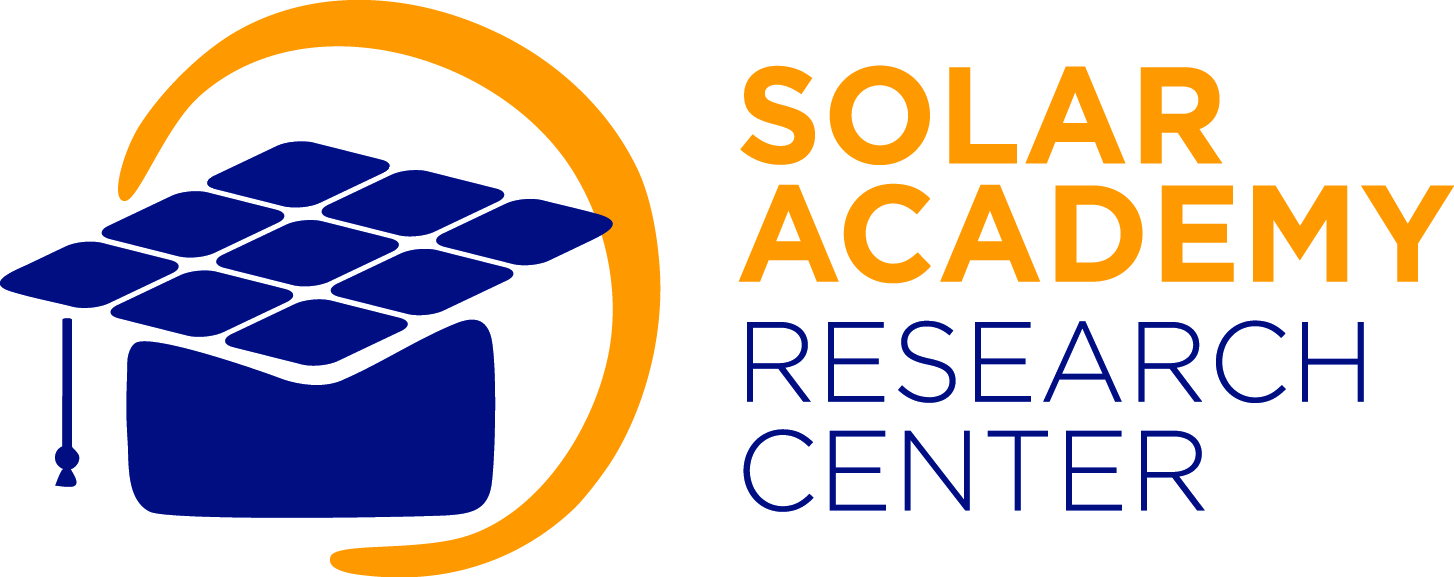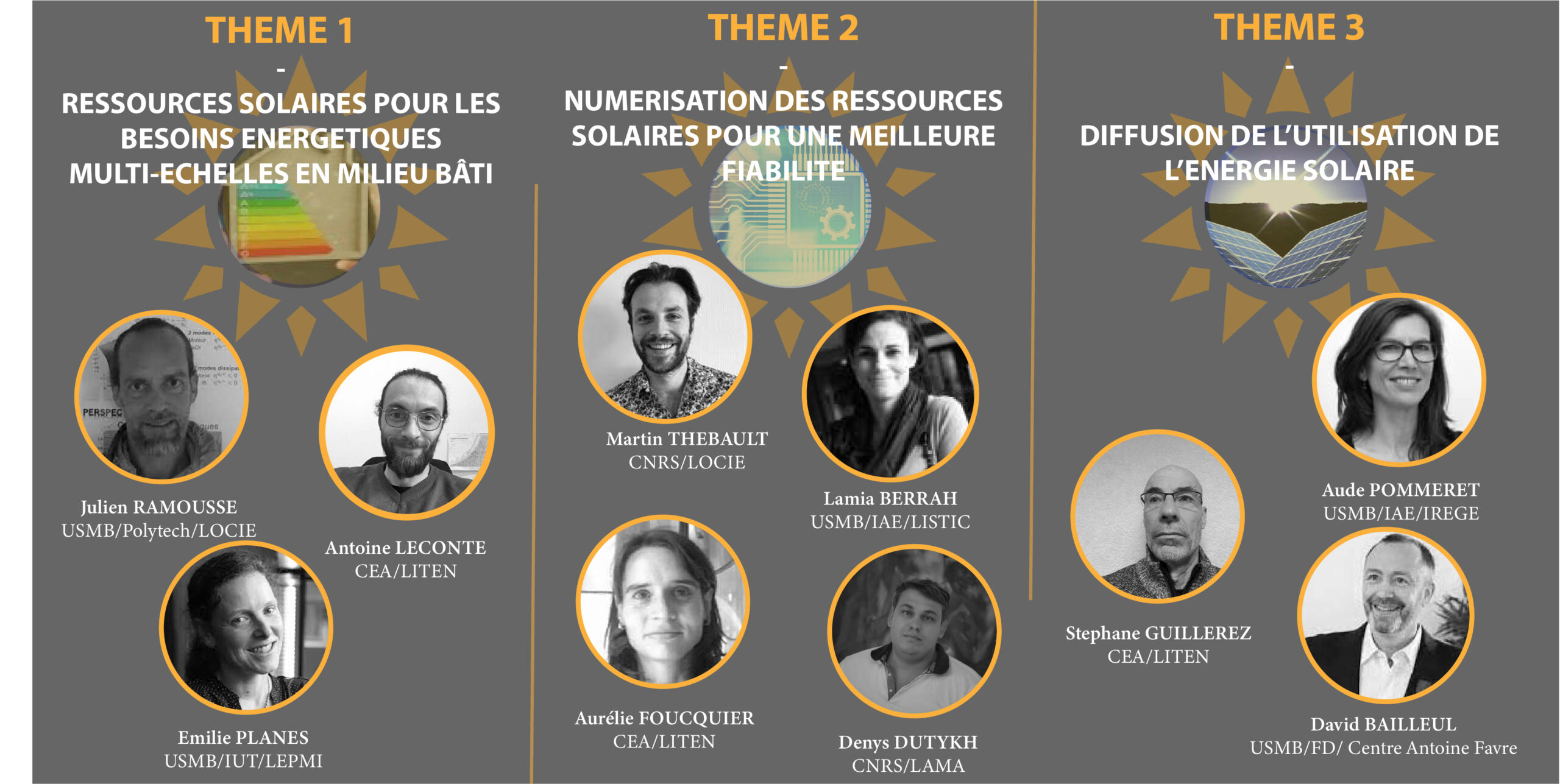 Solar Academy Research Center
Solar Academy Research Center
The research at Solar Academy is structured around 3 scientific poles:
- Solar resources for multi-scale energy needs (in the built environment).
- Digitization of the solar resource for better reliability
- Dissemination of the solar energy use
The scientific topics stem from the current gaps in knowledge, skills and experience that must be filled to overcome the significant challenges of deploying and using solar energy (photovoltaic and thermal) in the complex environments that are buildings and cities.
The objective of the research is to contribute to large-scale development of solar energy, by addressing multidisciplinary challenges.

 The energy efficiency of existing buildings can be improved through changes to the building envelope but also by the integration of energy harvesting technologies, such as BIPV (Building Integrated PhotoVoltaic systems) or BIPV/T (Thermal) with storage. However, energy generation potential is largely neglected from energy planning and urban planning policies at present. To realise the potential for distributed solar generation in the context of urban densification due to an increasing population, certain challenges must be overcome. One such hurdle is a lack of knowledge regarding solar resources due to shadowing, inter-building effects, multi-reflections, local climate factors, nebulosity, and soiling due to air pollution. In order to stimulate a transformative vision, and construct strong policies for building and urban development, new knowledge must be provided to policy-makers in terms of solar potential. This theme relies on the joint INES (CEA/USMB/CNRS/CSTB) research platform, the Labex CEMAM (for multifunctional materials) and also on existing INTERREG French-Swiss projects as G2 Solaire, PACs CAD… The optimisation of renewable energy collection will be considered from the building scale up to district and the city scales as a whole.
The energy efficiency of existing buildings can be improved through changes to the building envelope but also by the integration of energy harvesting technologies, such as BIPV (Building Integrated PhotoVoltaic systems) or BIPV/T (Thermal) with storage. However, energy generation potential is largely neglected from energy planning and urban planning policies at present. To realise the potential for distributed solar generation in the context of urban densification due to an increasing population, certain challenges must be overcome. One such hurdle is a lack of knowledge regarding solar resources due to shadowing, inter-building effects, multi-reflections, local climate factors, nebulosity, and soiling due to air pollution. In order to stimulate a transformative vision, and construct strong policies for building and urban development, new knowledge must be provided to policy-makers in terms of solar potential. This theme relies on the joint INES (CEA/USMB/CNRS/CSTB) research platform, the Labex CEMAM (for multifunctional materials) and also on existing INTERREG French-Swiss projects as G2 Solaire, PACs CAD… The optimisation of renewable energy collection will be considered from the building scale up to district and the city scales as a whole.
The theme will focus on the following actions:
- Innovative power generation technologies: the potential of novel materials, such as photovoltaic cells based on organic, polymer, hybrid or perovskite technologies, has been demonstrated as a complimentary choice to existing silicon and thin film architectures. Offering advantages such as being lightweight, flexible, and are suitable for low cost, large surface-area manufacturing processes, they may enhance access to energy, mobility or deployment in peri-urban or isolated locations.
- Integrated clean energy technologies for existing or new ZEB (Zero Energy Buildings): studies of retrofitting and newbuild projects integrating solar thermal and PV technologies. This action will address integration in urban environments, to expose impacts on efficiency, lifetime, and thus business models. New designs of solar building envelopes (adaptive, hybrid…), harvesting energy recovered from anthropogenic activities (that contribute to the urban heat ilanf effect), the soil layer (seen as solar collector) and underground (storage or exploitation of geothermal resource) will also be explored.
- Solar building design and solar city planning aims at realising the potential of solar energy collection through an optimal design and layout of buildings, whilst meeting aesthetic requirements. It is important to guide the design process at the scale of a district scale, in order to tackle urban densification and building interaction effects.
- Analysis and innovative design for solar buildings, cities & society through bio-inspired approaches. The system is studied by considering its functional similarities to a living organism. Approaches include considering the building and urban metabolism, Self-organisation principles, or describing districts and cities as forests (vertical organisation with solar collection at upper levels, and the access to the earth (water, geothermal resources) at lower levels.
Laboratories involved:
LOCIE Laboratory for Design Optimization and Environmental Engineering (UMR CNRS 5271) / Presentation /Web site
LEPMI, Laboratory of Electrochemistry and Physical Chemistry applied to Materials and Interfaces (UMR 5279) / Presentation /Web site
 To improve the accuracy of solar potential assessments in the built environment, an inter-connection of tools will be needed to handle multi-scale mathematical formulations and leverage digital platforms. Similarly, smart metering, decision-making tools and temporal and multi-criteria scorecards are needed for the deployment of solar energy. To engage with these topics, a broad skill set is needed, covering mathematics, information theory, digital and data sciences. It is important to understand complex systems and phenomena related to solar collection, conversion, storage, and at various scales. Such a platform must include 2D/3D drawing tools, robust formal, mathematical and scientific calculations, computing tools, tools able to process large amounts of data (including image processing and deep learning) and extract relevant information to ensure the performance and reliability of the systems.
To improve the accuracy of solar potential assessments in the built environment, an inter-connection of tools will be needed to handle multi-scale mathematical formulations and leverage digital platforms. Similarly, smart metering, decision-making tools and temporal and multi-criteria scorecards are needed for the deployment of solar energy. To engage with these topics, a broad skill set is needed, covering mathematics, information theory, digital and data sciences. It is important to understand complex systems and phenomena related to solar collection, conversion, storage, and at various scales. Such a platform must include 2D/3D drawing tools, robust formal, mathematical and scientific calculations, computing tools, tools able to process large amounts of data (including image processing and deep learning) and extract relevant information to ensure the performance and reliability of the systems.
This theme benefits from the MUST meso centre computing facility, which is part of the EGI (European Grid Initiative). In addition, this theme is also connected to the Equipex DURASOL that provide information regarding solar component ageing mechanisms and failure modes.
The broad skillset implied by this theme motivates the following actions:
Data Modelling and algorithm developments:
- Development of mathematical and advanced statistical models for scientific computing, a better understanding and management of complex systems
- Development of a digital platform for measuring, monitoring and improving energy efficiency of buildings and cities operation;
- Development a digital platform for modelling and processing in built environment: Building Information Modelling (BIM), City (CIM) and Territory (TIM) scale. This digitalisation combined with tooling allow convergence of layers of information concerning all the implied domain (Theme 1 – Theme 2- Theme 3)
- Tackle Multi-scale, Multi-time (past, real, forecast), Multi-physics and Multi-models from building to cities: optimisation of the distribution and production for ensuring Energy Flexibility and Security in real time.
Information Technology:
- Solar energy history analysis to study previous pitfalls and avoid repeating mistakes.
- Big data analytics and deep learning (through satellite imagery) in support of physical models, for a better estimation of solar energy at large spatial scales. Intelligent data driven decisions through specific techniques of data aggregation and indicator identification for decisional aid (for urban planning, business models, …).
- Performance, improvement and reliability through data mining (ex. Start-Up HelioCity is being created at LOCIE): fault analysis and fault detection.
Laboratories involved:
LAMA, Laboratory of Mathematics, UMR 5127 – CNRS / USMB / Presentation / Web site
LISTIC, Laboratory of Computer Science, Systems, Processing of Information and Knowledge / Presentation / Web site
 As a low-emission, and (increasingly) cost-competitive solution for local energy generation, solar technologies represent a disruptive threat to conventional business models of energy infrastructure. There are however a number of drawbacks that are a barrier to solar energy replacing conventional electricity supplies. These include intermittency, difficulties to integrate with existing electricity grids, social awareness, regulatory policies, environmental concerns, economic sustainability facing conventional energy, technology innovation and performance stability, and customer technology acceptance and satisfaction.
As a low-emission, and (increasingly) cost-competitive solution for local energy generation, solar technologies represent a disruptive threat to conventional business models of energy infrastructure. There are however a number of drawbacks that are a barrier to solar energy replacing conventional electricity supplies. These include intermittency, difficulties to integrate with existing electricity grids, social awareness, regulatory policies, environmental concerns, economic sustainability facing conventional energy, technology innovation and performance stability, and customer technology acceptance and satisfaction.
Theme 3 addresses these societal and economical barriers to facilitate market penetration. The book « Solar Energy Law » (2010) implied CDPPOC to challenge the future questions. More recently, the ANR REVE (2014-2017) implying IREGE have addressed intermittency effects on the profitability of solar panel adoption at the household level (whether households are equipped with smart meters and/or storage devices does affect the results) and therefore the public policy to be implemented in order to favour solar electricity penetration.
The actions developed in this theme therefore focus on:
Business issues:
- Assessing the economic value of solar systems from local-to macro-scale: the analysis could start at the household level, then expand to the level of a micro-grid, and finally to a regional level. At each level, different demand management and back-ups would have to be considered. Blockchain techniques will accelerate the move.
- Acceptability and appropriation of solar technology as well as Usage and behaviour analysis as no method is proven to restore a temporal load scenario in residential buildings. Consumers may also become producers (prosumers) that add complexity to the explored models.
- Successful business models in solar are yet to be set up and it is likely that they will appear mainly in the downstream segment in Europe.
- Electricity consumers/prosumers optimal behaviour in terms of investment in facades solar panels and electricity use. Accounting for the behaviour of household/firms present in the building as users of the electricity produced and/or providers of the electricity generated.
- Implementation of the planning through public policies: net-metering, feed-in tariffs or subsidies to storage devices as means to reach the maximum solar generation.
Law and Policies issues:
- Conflict of use management (energy and environmental performance) requires legal considerations;
- Tort and contract must be mobilized to ensure the passage of an individual logic to a collective logic. The challenge is to succeed in moving from an « isolated » production-consumption system to an « integrated » system capable of associating several entities (individuals, collectives, companies …) in order to pool the functions of producer and consumer of energy, and to share the expenses as the benefits
- Creation of links between local private action – driven by the civil sphere and the socio-economic sector – and local public action in order to ensure continuity between projects at different scales (individual, local, territorial, national and supranational) and to allow the adaptation of the regulatory models they induce
- Local or territorial bodies key role by stimulating solar energy development and private initiative (tax or financial incentives, planning, town planning, security of supply, experiments, public investment or portage of solar energy projects …).
Each scientific theme will be coordinated by a Scientific leader in charge of the organization of research activities following the scientific objectives described above, in connection with the international network of academic partners, companies and other socio-economic partners of SOLAR (competitiveness clusters, local authorities from the region and beyond (ex. Switzerland).
Laboratories involved :
IREGE, Management and Economy Research Institute (EA 2426 /USMB) / Presentation / Website
Law Research Centre Antoine Favre (EA 4143 / USMB) / Presentation / Website
LLSETI, Languages, Literature and Society: International and Cross-border studies (EA 3706 / USMB) / Presentation / Website
